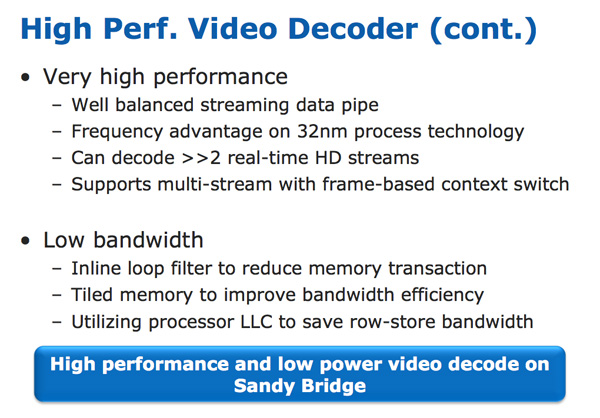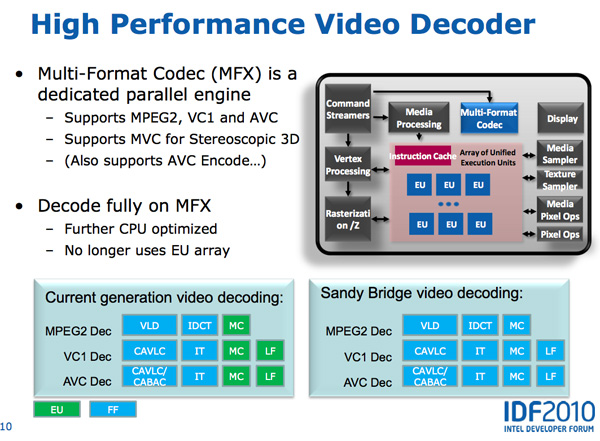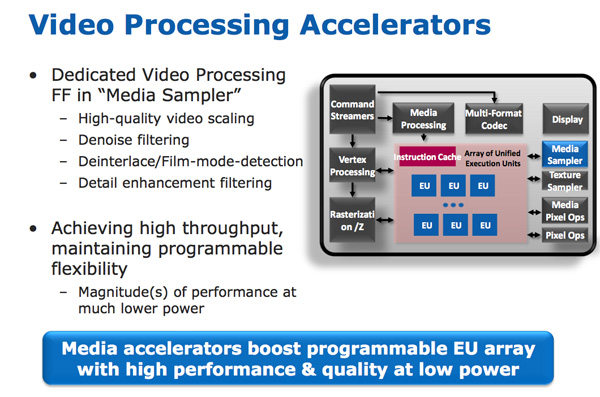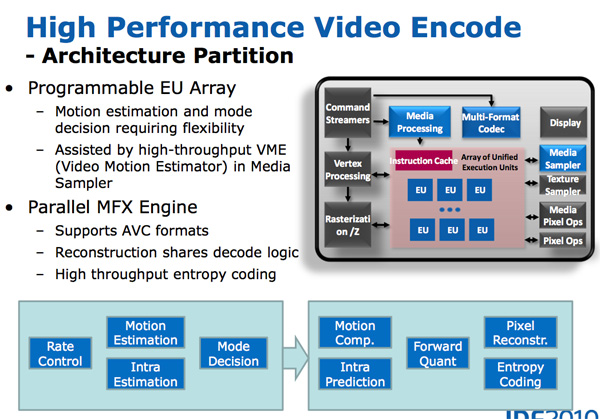The Sandy Bridge Review: Intel Core i7-2600K, i5-2500K and Core i3-2100 Tested
by Anand Lal Shimpi on January 3, 2011 12:01 AM ESTIntel’s Quick Sync Technology
In recent years video transcoding has become one of the most widespread consumers of CPU power. The popularity of YouTube alone has turned nearly everyone with a webcam into a producer, and every PC into a video editing station. The mobile revolution hasn’t slowed things down either. No smartphone can play full bitrate/resolution 1080p content from a Blu-ray disc, so if you want to carry your best quality movies and TV shows with you, you’ll have to transcode to a more compressed format. The same goes for the new wave of tablets.
At a high level, video transcoding involves taking a compressed video stream and further compressing it to better match the storage and decoding abilities of a target device. The reason this is transcoding and not encoding is because the source format is almost always already encoded in some sort of a compressed format. The most common, these days, being H.264/AVC.
Transcoding is a particularly CPU intensive task because of the three dimensional nature of the compression. Each individual frame within a video can be compressed; however, since sequential frames of video typically have many of the same elements, video compression algorithms look at data that’s repeated temporally as well as spatially.
I remember sitting in a hotel room in Times Square while Godfrey Cheng and Matthew Witheiler of ATI explained to me the challenges of decoding HD-DVD and Blu-ray content. ATI was about to unveil hardware acceleration for some of the stages of the H.264 decoding pipeline. Full hardware decode acceleration wouldn’t come for another year at that point.
The advent of fixed function video decode in modern GPUs is important because it helped enable GPU accelerated transcoding. The first step of the video transcode process is to first decode the source video. Since transcoding involves taking a video already in a compressed format and encoding it in a new format, hardware accelerated video decode is key. How fast a decode engine is has a tremendous impact on how fast a hardware accelerated video encode can run. This is true for two reasons.
First, unlike in a playback scenario where you only need to decode faster than the frame rate of the video, when transcoding the video decode engine can run as fast as possible. The faster frames can be decoded, the faster they can be fed to the transcode engine. The second and less obvious point is that some of the hardware you need to accelerate video encoding is already present in a video decode engine (e.g. iDCT/DCT hardware).
With video transcoding as a feature of Sandy Bridge’s GPU, Intel beefed up the video decode engine from what it had in Clarkdale. In the first generation Core series processors, video decode acceleration was split between fixed function decode hardware and the GPU’s EU array. With Sandy Bridge and the second generation Core CPUs, video decoding is done entirely in fixed function hardware. This is not ideal from a flexibility standpoint (e.g. newer video codecs can’t be fully hardware accelerated on existing hardware), but it is the most efficient method to build a video decoder from a power and performance standpoint. Both AMD and NVIDIA have fixed function video decode hardware in their GPUs now; neither rely on the shader cores to accelerate video decode.
The resulting hardware is both performance and power efficient. To test the performance of the decode engine I launched multiple instances of a 15Mbps 1080p high profile H.264 video running at 23.976 fps. I kept launching instances of the video until the system could no longer maintain full frame rate in all of the simultaneous streams. The graph below shows the maximum number of streams I could run in parallel:
| Intel Core i5-2500K | NVIDIA GeForce GTX 460 | AMD Radeon HD 6870 | |
| Number of Parallel 1080p HP Streams | 5 streams | 3 streams | 1 stream |
AMD’s Radeon HD 6000 series GPUs can only manage a single high profile, 1080p H.264 stream, which is perfectly sufficient for video playback. NVIDIA’s GeForce GTX 460 does much better; it could handle three simultaneous streams. Sandy Bridge however takes the cake as a single Core i5-2500K can decode five streams in tandem.

The Sandy Bridge decoder is likely helped by the very large (and high bandwidth) L3 cache connected to it. This is the first advantage Intel has in what it calls its Quick Sync technology: a very fast decode engine.
The decode engine is also reused during the actual encode phase. Once frames of the source video are decoded, they are actually fed to the programmable EU array to be split apart and prepared for transcoding. The data in each frame is transformed from the spatial domain (location of each pixel) to the frequency domain (how often pixels of a certain color appear); this is done by the use of a discrete cosine transform. You may remember that inverse discrete cosine transform hardware is necessary to decode video; well, that same hardware is useful in the domain transform needed when transcoding.
Motion search, the most compute intensive part of the transcode process, is done in the EU array. It's the combination of the fast decoder, the EU array, and fixed function hardware that make up Intel's Quick Sync engine.













283 Comments
View All Comments
saikyan - Thursday, January 6, 2011 - link
"perhaps we should return to just labeling these things with their clock speeds and core counts? After all, it’s what Apple does—and that’s a company that still refuses to put more than one button on its mice. Maybe it’s worth a try."I hate to sound like the resident Mac fanboy (I'm platform agnostic) but I want to point out:
1. Apple sells by trim and display, they don't really make a big deal of the CPU (probably because they stick to low-end and midrange CPUs)
2. They have been shipping multi-button mice for nearly six years now. Come on!
vol7ron - Friday, January 7, 2011 - link
- gtx460 image quality definitely the worst- 6870 image quality next
- quicksync/snb image quality are the best (marginally better than 6870); I did notice some color loss in the flowers behind the umbrella when I zoomed in on the quicksync picture, so I'd have to give SNB the title in terms of quality. QuickSync gets the title in terms of performance.
nitrousoxide - Monday, January 10, 2011 - link
lmaoBurticus - Monday, January 10, 2011 - link
My last Intel cpu was a prescott 2.4ghz P4 OC'd to over 3ghz... back in 2004? My last 3 main system builds all AMD.... I was thinking about going to an X6 in the near future, now I guess maybe not. My price point is pretty much $200 for the cpu + motherboard so maybe I'll have to wait a couple months.Suddenly my 2 year old Phenom II seems very, very slow...
magnusr - Tuesday, January 11, 2011 - link
I just received my 2600K. It only had the normal fan. No special heatsink/fan for the 2600K. The same heatsink as the rest....This is a fraud since I placed my decision to take 2600K instead of the 2500K based on the better heatsink and the cache.
mmcnally - Tuesday, January 11, 2011 - link
Same here.. Very disapointed as I would have purchased a better heatsink if I knew. I guess I'll just do the install with the standard crap HS and hold off on over-clocking until I get a better one.swing848 - Tuesday, January 11, 2011 - link
Many of us are using older equipment. And, for those of us with limited funds it would have been nice if you would have added the Intel Q9650 and run all game benchmarks at 3.4GHz [ the speed of the 2600K], except for the default 3.6GHz speed of the X4 975BE, leave it there.I have a QX9650 that I purchased from eBay and it does 4GHz+ with ease, in a Gigabyte P35-DS3R motherboard, even with my ancient cooler [Thermalright XP-90] that I pulled from a socket 478 motherboard [$5 adapter].
Note: I lapped the XP-90 with a slight convex shape to better use with un-lapped CPUs.
In any event, a "quick and dirty" or simple overclock would have yielded at least some usable information. To save time, no need to try to get the maximum speed from all components.
As long as the CPUs were already overclocked, you could run all benchmarks at those speeds, not just games. Many of us overclock to get more for our money.
You included the ancient Q6600 at it's slow default speed - in some of the benchmarks. Why didn't you include it in all benchmarks?
Your normal benchmark page does not include a full, or nearly full, list of games and CPUs, so, comparisons are difficult to find, example here anandtech.com/bench/CPU/62
Where does this leave those of us with older equipment that is still chugging along?
Kell_sw - Thursday, January 13, 2011 - link
DRM inside the cpu? People is blind?. The sad thing, everybody is going to buy this.Sweeo - Friday, January 14, 2011 - link
I just bought a upgrade "kit" from an core 2 2.8 quad to i7 950 :(but I got 6 sata ports I noticed the new boards have 4+2
will the more advanced boards have more ?
Ahumado - Sunday, January 16, 2011 - link
I didn't see it discussed. Did I miss it?